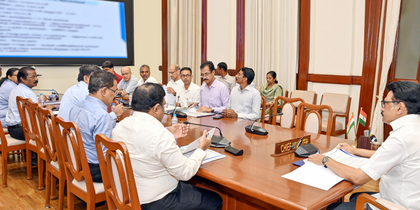TN bears greater financial burden for central schemes, official data reveals
By IANS | Updated: June 14, 2025 19:58 IST2025-06-14T19:50:06+5:302025-06-14T19:58:33+5:30
Chennai, June 14 Despite being labelled as Central schemes, the Tamil Nadu government contributes a significantly higher share ...

TN bears greater financial burden for central schemes, official data reveals
Chennai, June 14 Despite being labelled as Central schemes, the Tamil Nadu government contributes a significantly higher share of funds than the Union government in at least six major welfare and infrastructure programmes, according to official documents from the State governments.
The schemes in question include three under the National Social Assistance Programme (NSAP) -- the Indira Gandhi National Old Age Pension Scheme (IGNOAPS), Indira Gandhi National Widow Pension Scheme (IGNWPS), and Indira Gandhi National Disability Pension Scheme (IGNDPS) -- as well as the Pradhan Mantri Awas Yojana (PMAY-Rural), Pradhan Mantri Matsya Sampada Yojana (PMMSY), and the Jal Jeevan Mission (JJM).
The NSAP, launched in 1995 as a fully Central-funded initiative, was preceded by Tamil Nadu’s own pension scheme, which began in January 1962.
Between 1974 and 1984, the State expanded its support to include persons with disabilities, widows, agricultural labourers, and deserted women.
These were eventually brought under the national scheme in 2007.
Under the IGNOAPS and IGNWPS, the Centre provides a modest monthly contribution of Rs 200 or Rs 300 for beneficiaries below 80 years, and Rs 500 for those aged 80 and above. It is the Tamil Nadu government that tops up this amount, providing an additional Rs 1,000, Rs 900, or Rs 700, depending on the category, ensuring that the final payout reaches Rs 1,200 per beneficiary.
Similarly, under IGNDPS, beneficiaries receive Rs 1,500, of which only Rs 300 or Rs 500 is borne by the Centre. The rest is funded by the State government.
Tamil Nadu also independently supports persons with disabilities through a separate scheme, offering Rs 1,500 to each beneficiary. In the case of PMAY-Rural, the nominal cost-sharing ratio is 60:40 (Centre: State) in plain areas.
However, Tamil Nadu contributes significantly more. The total unit cost of a house in the State is Rs 2,83,900, factoring in RCC roofing and components from MGNREGS and Swachh Bharat (Rural). Of this, the Centre provides Rs 1,11,100 while the State contributes Rs 1,72,800, effectively resulting in a 39:61 split.
Under the PMMSY, while the prescribed cost-sharing formula allocates 60 per cent to the Centre and 40 per cent to the State, implementation figures show that Tamil Nadu ends up bearing 73 per cent of the cost, with only 27 per cent coming from the Centre.
The Jal Jeevan Mission, which mandates a 50:50 cost-sharing model, also sees a higher contribution from the State in practice -- 55 per cent, compared to the Centre’s 45 per cent. These figures highlight a recurring trend where Tamil Nadu takes on a disproportionately higher financial responsibility in schemes designed and advertised as centrally sponsored.
Disclaimer: This post has been auto-published from an agency feed without any modifications to the text and has not been reviewed by an editor
Open in app